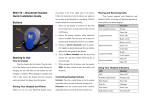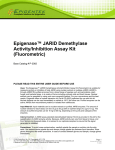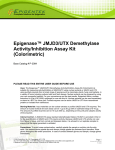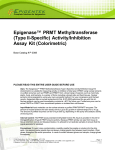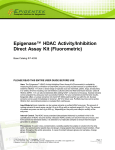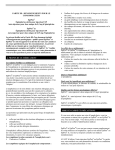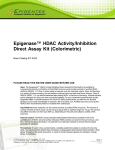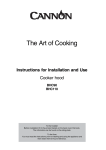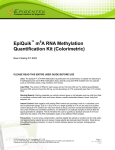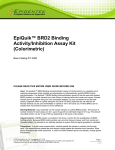Download Epigenase™ 5-mC Hydroxylase TET Activity/Inhibition
Transcript
EPIGENTEK Complete Solutions for Epigenetics Epigenase™ LSD1 Demethylase Activity/Inhibition Assay Kit (Colorimetric) Base Catalog # P-3078 PLEASE READ THIS ENTIRE USER GUIDE BEFORE USE Uses: The Epigenase™ LSD1 Demethylase Activity/Inhibition Assay Kit (Colorimetric) is suitable for measuring LSD1 activity/inhibition using nuclear extracts or purified enzymes from a broad range of species such as mammals, plants, fungi, and bacteria, in a variety of forms including cultured cells and fresh tissues. Nuclear extracts can be prepared by using your own successful method. For your convenience and the best results, Epigentek offers a nuclear extraction kit (Cat. No. OP-0002) that is optimized for use with this kit. Nuclear extracts can be used immediately or stored at –80°C for future use. Purified enzymes can be active LSD1 from recombinant proteins or isolated from cell/tissues. Input Material: Input materials can be nuclear extracts or purified LSD1 enzymes. The amount of nuclear extracts for each assay can be 0.5 µg to 20 µg with an optimal range of 5-10 µg. The amount of purified enzymes can be 5 ng to 500 ng, depending on the purity and catalytic activity of the enzymes. Internal Control: The LSD1 assay standard (demethylated hsitone H3-K4) is provided in this kit for quantification of LSD1 enzyme activity. Because LSD1 activity can vary from tissue to tissue, and from normal and diseased states, it is advised to run replicate samples to ensure that the signal generated is validated. Precautions: To avoid cross-contamination, carefully pipette the sample or solution into the strip wells. Use aerosol-barrier pipette tips and always change pipette tips between liquid transfers. Wear gloves throughout the entire procedure. In case of contact between gloves and sample, change gloves immediately. 110 Bi County Blvd. Ste. 122, Farmingdale, NY 11735 Tel: 1-877-374-4368 ■ Fax: 1-718-484-3956 ■ E-mail: [email protected] ■ Web: www.epigentek.com © Epigentek Group Inc. All rights reserved. Products are for research use only. Page 1 Printed 2014-08-21 P-3078 EPIGENTEK Complete Solutions for Epigenetics KIT CONTENTS Component 48 Assays Cat. #P-3078-48 96 Assays Cat. #P-3078-96 Storage Upon Receipt LD1 (10X Wash Buffer) 14 ml 28 ml 4°C LD2 (LSD1 Assay Buffer) 4 ml 8 ml RT LD3 (LSD1 Substrate, 50 µg/ml)* 60 µl 120 µl –20°C LD4 (LSD1 Assay Standard, 50 µg/ml)* 10 µl 20 µl –20°C LD5 (Capture Antibody, 1000 µg/ml*) 5 µl 10 µl 4°C LD6 (Detection Antibody, 400 µg/ml)* 6 µl 12 µl –20°C LD7 (LSD1 Inhibitor Tranylcypromine, 1 mM)* 20 µl 40 µl 4°C LD8 (Developer Solution) 5 ml 10 ml 4°C LD9 (Stop Solution) 5 ml 10 ml RT 8-Well Assay Strips (With Frame) 6 12 4°C Adhesive Covering Film 1 1 RT User Guide 1 1 RT * Spin the solution down to the bottom prior to use. SHIPPING & STORAGE The kit is shipped in two parts: the first part at ambient room temperature and the second part on frozen ice packs at 4°C. Upon receipt: (1) Store LD3, LD4, and LD6 at –20°C away from light; (2) Store LD1, LD5, LD7, LD8, and 8-Well Assay Strips at 4°C away from light; (3) Store remaining components (LD2, LD9, and Adhesive Covering Film) at room temperature away from light. All components of the kit are stable for 6 months from the date of shipment, when stored properly. Note: (1) Check if LD1 (10X Wash Buffer) contains salt precipitates before use. If so, warm (at room temperature or 37°C) and shake the buffer until the salts are re-dissolved; and (2) check if a blue color is present in LD8 (Developer Solution), which would indicate contamination of the solution and should not be used. To avoid contamination, transfer the amount of LD8 required into a secondary container (tube or vial) before adding LD8 into the assay wells. MATERIALS REQUIRED BUT NOT SUPPLIED Adjustable pipette or multiple-channel pipette Multiple-channel pipette reservoirs Aerosol resistant pipette tips Microplate reader capable of reading absorbance at 450 nm 1.5 ml microcentrifuge tubes 110 Bi County Blvd. Ste. 122, Farmingdale, NY 11735 Tel: 1-877-374-4368 ■ Fax: 1-718-484-3956 ■ E-mail: [email protected] ■ Web: www.epigentek.com © Epigentek Group Inc. All rights reserved. Products are for research use only. Page 2 Printed 2014-08-21 P-3078 EPIGENTEK Complete Solutions for Epigenetics Incubator for 37°C incubation Distilled water Nuclear extract or purified enzymes Parafilm M or aluminum foil GENERAL PRODUCT INFORMATION Quality Control: Each lot of the Epigenase™ LSD1 Demethylase Activity/Inhibition Assay Kit (Colorimetric) is tested against predetermined specifications to ensure consistent product quality. Epigentek guarantees the performance of all products in the manner described in our product instructions. Product Warranty: If this product does not meet your expectations, simply contact our technical support unit or your regional distributor. We also encourage you to contact us if you have any suggestions about product performance or new applications and techniques. Safety: Suitable lab coat, disposable gloves, and proper eye protection are required when working with this product. Product Updates: Epigentek reserves the right to change or modify any product to enhance its performance and design. The information in this User Guide is subject to change at any time without notice. Thus, only use the User Guide that was supplied with the kit when using that kit. Usage Limitation: The Epigenase™ LSD1 Demethylase Activity/Inhibition Assay Kit (Colorimetric) is for research use only and is not intended for diagnostic or therapeutic application. Intellectual Property: The Epigenase™ LSD1 Demethylase Activity/Inhibition Assay Kit (Colorimetric) and methods of use contain proprietary technologies by Epigentek. A BRIEF OVERVIEW Lysine histone methylation is one of the most robust epigenetic marks and is essential for the regulation of multiple cellular processes. The methylation of H3-K4 seems to be of particular significance, as it is associated with active regions of the genome. H3-K4 methylation was considered irreversible until the identification of a large number of histone demethylases indicated that demethylation events play an important role in histone modification dynamics. So far at least 2 classes of H3-K4 specific histone demethylase, LSD1 (BHC110, KDM1) and JARIDs have been identified. LSD1 can remove di- and mono-methylation from H3-K4 by using an amine oxidase reaction. LSD1 is associated with complexes that function as both transcriptional inactivators and activators. It demethylates mono-/di-methyl H3-K4 when associated with the Co-REST complex at neuronal genes, or mono-/di-methyl H3-K9 when associated with the androgen receptor. Fig 1. Histone H3-K4 demethylation reaction catalyzed by LSD1 110 Bi County Blvd. Ste. 122, Farmingdale, NY 11735 Tel: 1-877-374-4368 ■ Fax: 1-718-484-3956 ■ E-mail: [email protected] ■ Web: www.epigentek.com © Epigentek Group Inc. All rights reserved. Products are for research use only. Page 3 Printed 2014-08-21 P-3078 EPIGENTEK Complete Solutions for Epigenetics LSD1 is found to be pivotal in development and differentiation. For example, this enzyme is required to induce skeletal muscle differentiation, and mutation of drosophila LSD1 results in tissue-specific defect in development through disrupting H3-K4 methylation. LSD1 is also shown to participate in regulation of chromatin remodeling, cell death and global DNA methylation. More importantly, LSD1 is found to be involved in some pathological processes such as cancer and inflammatory diseases. For example, expression of LSD1 is observed in cancer and LSD1 triggers MYC and E2F-mediated transcription in cancer cells. Detection of activity and inhibition of LSD1 would be important in elucidating mechanisms of epigenetic regulation of gene activation and silencing and benefiting cancer diagnostics and therapeutics. There are only a couple of methods used for detecting LSD1 activity/inhibition. These methods are based on the measurement of H2O2 or formaldehyde release, a by-product of LSD1 enzymatic reaction and have significant weaknesses including: (1) Large amount (at µg: level) of substrate and enzyme are required; (2) Nuclear extracts from cell/tissues can not be used; (3) Redox-sensitive LSD1 inhibitiors are not suitable for testing with these methods; (4) Highly interfered by DMSO and thiolcontaining chemicals, which are often contained in enzyme solution or tested compound solvents; and (5) Less accuracy than direct measurement of LSD1-converted demethylated product. These problems were averted with the earlier EpiQuik™ Histone Demethylase LSD1 Activity/Inhibition Assay Kit, a popular assay method for LSD1 activity/inhibition. We have now added an improved version, the Epigenase™ LSD1 Activity/Inhibition Assay Kit (Colorimetric). This latest method retains the simplicity, rapidness, high throughput, and non-radioactivity featured in the previous version, and has the following advantages: Strip-well microplate format makes the assay flexible and quick: manual or high throughput analysis that can be completed within 3 hours. Enhanced kit composition enables background signals to be extremely low, which allows the assay to be more accurate, sensitive, reliable, and consistent. Innovative colorimetric assay directly measures LSD1 activity by a straightforward detection of LSD1-converted demethylated product, rather than by-products. Thus it eliminates assay interferences caused by thiol-containing chemicals such as DTT, GSH, and 2-mercaptoethanol. Both cell/tissue extracts and purified LSD1 can be used, which allows for the detection of inhibitory effects of LSD1 inhibitor in vivo and in vitro. Novel assay principle allows high sensitivity to be achieved. The activity can be detected from as low as 5 ng of purified LSD1 enzyme, which is about 20 fold higher than that obtained by H2O2/formaldehyde release-based LSD1 assays. Demethylated H3-K4 standard is included, which allows the specific activity of LSD1 to be quantified. PRINCIPLE & PROCEDURE The Epigenase™ LSD1 Demethylase Activity/Inhibition Assay Kit (Colorimetric) contains all reagents necessary for the measurement of LSD1 activity/inhibition. In this assay, di-methylated histone H3-K4 LSD1 substrate is stably coated onto the strip wells. Active LSD1 binds to the substrate and removes methyl groups from the substrate. The LSD1-demethylated products can be recognized with a specific antibody. The ratio or amount of demethylated products, which is proportional to enzyme activity, can then be colorimetrically measured by reading the absorbance in a colorimetric microplate reader at a wavelength of 450 nm. The activity of LSD1 enzyme is proportional to the optical density intensity measured. 110 Bi County Blvd. Ste. 122, Farmingdale, NY 11735 Tel: 1-877-374-4368 ■ Fax: 1-718-484-3956 ■ E-mail: [email protected] ■ Web: www.epigentek.com © Epigentek Group Inc. All rights reserved. Products are for research use only. Page 4 Printed 2014-08-21 P-3078 EPIGENTEK Complete Solutions for Epigenetics 1.2 2 R = 0.9986 1 OD450 nm 0.8 0.6 0.4 0.2 0 0 50 100 150 200 250 LSD1 (ng) Demonstration of high sensitivity of LSD1 activity assay achieved by using recombinant LSD1 with EpigenaseTM LSD1 Activity/Inhibition Assay Ultra Kit 100 90 80 Schematic procedure of EpigenaseTM LSD1 Demethylase Activity/Inhibition Assay Kit (Colorimetric). %Inhibition 70 60 50 40 30 20 10 0 0 10 20 50 100 200 500 Tranylcypromine (uM) Demonstration of inhibitory effect of LSD1 inhibitor detected by EpigenaseTM LSD1 Activity/Inhibition Assay Ultra Kit. LSD1 concentration: 200 ng/well. PROTOCOL For the best results, please read the protocol in its entirety prior to starting your experiment. Starting Materials 110 Bi County Blvd. Ste. 122, Farmingdale, NY 11735 Tel: 1-877-374-4368 ■ Fax: 1-718-484-3956 ■ E-mail: [email protected] ■ Web: www.epigentek.com © Epigentek Group Inc. All rights reserved. Products are for research use only. Page 5 Printed 2014-08-21 P-3078 EPIGENTEK Complete Solutions for Epigenetics Input Amount: The amount of nuclear extracts for each assay can be 0.5 µg to 20 ug with optimized range of 5-10 µg. The amount of purified enzymes can be 5 ng to 500 ng, depending on the purity and catalatic activity of the enzymes. Nuclear Extraction: You can use your method of choice for preparing nuclear extracts. Epigentek also offers a nuclear extraction kit (Cat. No. OP-0002) optimized for use with this kit. Nuclear Extract or Purified LSD1 Storage: Nuclear extract or purified LSD1 enzyme should be stored in aliquots at –80°C until use. 1. Working Buffer and Solution Preparation a. Prepare Diluted LD1 1X Wash Buffer: 48-Assay Kit: Add 13 ml of LD1 10X Wash Buffer to 117 ml of distilled water and adjust pH to 7.2-7.5. 96-Assay Kit: Add 26 ml of LD1 10X Wash Buffer to 234 ml of distilled water and adjust pH to 7.2-7.5. This Diluted LD1 1X Wash Buffer can now be stored at 4°C for up to six months. b. Prepare Diluted LD5 Capture Antibody Solution: Dilute LD5 Capture Antibody with Diluted LD1 1X Wash Buffer at a ratio of 1:1000 (add 1 µl of LD5 to 1000 µl of Diluted LD1 1X Wash Buffer). 50 µl of Diluted LD5 will be required for each assay well. c. Prepare Diluted LD6 Detection Antibody Solution: Dilute LD6 Detection Antibody with Diluted LD1 1X Wash Buffer at a ratio of 1:2000 (add 1 µl of LD6 Detection Antibody to 2000 µl of Diluted LD1 1X Wash Buffer). 50 µl of Diluted LD6 will be required for each assay well. d. Prepare Diluted LD4 Standard Solution: Suggested Standard Curve Preparation: First, dilute LD4 with LD2 to 5 ng/µl by adding 1 µl of LD4 to 9 µl of LD2. Then, further prepare five concentrations by combining the 5 ng/µl diluted LD4 with LD2 into final concentrations of 0.2, 0.5, 1, 2, and 5 ng/µl according to the following dilution chart: LD2 Resulting LD4 Concentration Tube LD4 (5 ng/µl) 1 1.0 µl 24.0 µl 0.2 ng/µl 2 1.0 µl 9.0 µl 0.5 ng/µl 3 1.0 µl 4.0 µl 1.0 ng/µl 4 2.0 µl 3.0 µl 2.0 ng/µl 5 4.0 µl 0.0 µl 5.0 ng/µl Note: Keep each of diluted solutions except Diluted LD1 1X Wash Buffer on ice until use. Any remaining diluted solutions other than Diluted LD1 should be discarded if not used within the same day. 2. Enzymatic Reaction a. Predetermine the number of strip wells required for your experiment. It is advised to run replicate samples (include blank and positive control) to ensure that the signal generated is validated. Carefully 110 Bi County Blvd. Ste. 122, Farmingdale, NY 11735 Tel: 1-877-374-4368 ■ Fax: 1-718-484-3956 ■ E-mail: [email protected] ■ Web: www.epigentek.com © Epigentek Group Inc. All rights reserved. Products are for research use only. Page 6 Printed 2014-08-21 P-3078 EPIGENTEK Complete Solutions for Epigenetics remove un-needed strip wells from the plate frame and place them back in the bag (seal the bag tightly and store at 4°C). b. Blank Wells: Add 49 µl of LD2 and 1 µl of LD3 to each blank well. c. Standard Wells: For a standard curve, add 49 µl of LD2 and 1 µl of Diluted LD4 standard solution to each standard well with a minimum of five wells, each at a different concentration between 0.2 to 5 ng/µl (based on the dilution chart in Step 1d; see Table 3 as an example). d. Sample Wells Without Inhibitor: Add 45 to 48 µl of LD2, 1 µl of LD3, and 1 to 4 µl of your nuclear extracts or 1 to 4 µl of your purified LSD1 enzyme to each sample well without inhibitor. Total volume should be 50 µl per well. e. Sample Well With Inhibitor: Add 40 to 43 µl of LD2, 1 µl of LD3, 1 to 4 µl of your nuclear extracts or 1 to 4 µl of your purified LSD1 enzyme, and 5 µl of inhibitor solution. Total volume should be 50 µl per well. Note: (1) Follow the suggested well setup diagrams; (2) It is recommended to use 2 µg to 10 µg of nuclear extract per well or 10 ng to 100 ng of purified enzyme per well; (3) The concentration of inhibitors to be added into the sample wells can be varied (e.g., 1 µM to 1000 µM). However, the final concentration of the inhibitors before adding to the wells should be prepared with LD2 at a 1:10 ratio (e.g., add 0.5 µl of inhibitor to 4.5 µl of LD2), so that the original solvent of the inhibitor can be reduced to 1% of the reaction solution or less. The LSD1 inhibitor, Tranylcypromine (LD7) included in the kit can be used as a control inhibitor. f. Tightly cover strip-well microplate with Adhesive Covering Film to avoid evaporation and incubate at 37°C for 60-120 min. Note: (1) The incubation time may depend on intrinsic LSD1 activity. However, in general, 60-90 min incubation is suitable for active purified LSD1 enzymes and 90-120 min incubation is required for nuclear extracts; (2) The Adhesive Covering Film can be cut to the required size to cover the strips based on the number of strips to be used. g. Remove the reaction solution from each well. Wash each well with 150 µl of the Diluted LD1 1X Wash Buffer each time for three times. 3. Antibody Binding & Signal Enhancing a. Add 50 µl of the Diluted LD5 to each well, then cover with Parafilm M or aluminium foil and incubate at room temperature for 60 min. b. Remove the Diluted LD5 solution from each well. c. Wash each well with 150 µl of the Diluted LD1 each time for three times. d. Add 50 µl of the Diluted LD6 to each well, then cover with Parafilm M or aluminium foil and incubate at room temperature for 30 min. e. Remove the Diluted LD6 solution from each well. f. Wash each well with 150 µl of the Diluted LD1 each time for four times. Note: Ensure any residual wash buffer in the wells is removed as much as possible at each wash step. 110 Bi County Blvd. Ste. 122, Farmingdale, NY 11735 Tel: 1-877-374-4368 ■ Fax: 1-718-484-3956 ■ E-mail: [email protected] ■ Web: www.epigentek.com © Epigentek Group Inc. All rights reserved. Products are for research use only. Page 7 Printed 2014-08-21 P-3078 EPIGENTEK Complete Solutions for Epigenetics 4. Signal Detection a. Add 100 µl of LD8 to each well and incubate at room temperature for 1 to 10 min away from light. Begin monitoring color change in the sample wells and control wells. The LD8 solution will turn blue in the presence of sufficient demethylated products. b. Add 100 µl of LD9 to each well to stop enzyme reaction when color in the positive control wells turns medium blue. The color will change to yellow after adding LD9 and the absorbance should be read on a microplate reader within 2 to 10 min at 450 nm with an optional reference wavelength of 655 nm. Note: (1) Most microplate readers have the capability to carry out dual wavelength analysis and will automatically subtract reference wavelength absorbance from the test wavelength absorbance. If your plate reader does not have this capability, the plate can be read twice, once at 450 nm and once at 655 nm. Then, manually subtract the 655 nm ODs from 450 nm ODs; (2) If the strip-well microplate frame does not fit in the microplate reader, transfer the solution to a standard 96-well microplate. 5. LSD1 Activity Calculation a. Calculate the average duplicate readings for the sample wells and blank wells. b. Calculate LSD1 activity or inhibition using the following formulas: For simple calculation: (Sample OD – Blank OD) x 1000 LSD1 Activity (OD/min/mg) = (Protein Amount (µg)* x min**) * Protein amount (µg) added into the reaction at step 2d. ** Incubation time (minutes) at step 2f. Example calculation: Average OD450 of sample is 0.65 Average OD450 of blank is 0.05 Protein amount is 5 µg Incubation time is 120 minutes (2 hours) LSD1 activity = (0.65 – 0.05) x 1000 = 1 OD/min/mg (5 x 120) For accurate or specific activity calculation: 1. Generate a standard curve and plot OD value versus amount of LD4 at each concentration point. 2. Determine the slope as OD/ng (you can use Microsoft Excel statistical functions for slope calculation), then calculate the amount of LSD1-converted demethylated product using the following formulas: 110 Bi County Blvd. Ste. 122, Farmingdale, NY 11735 Tel: 1-877-374-4368 ■ Fax: 1-718-484-3956 ■ E-mail: [email protected] ■ Web: www.epigentek.com © Epigentek Group Inc. All rights reserved. Products are for research use only. Page 8 Printed 2014-08-21 P-3078 EPIGENTEK Complete Solutions for Epigenetics (Sample OD – Blank OD) Demethylated product (ng) = Slope Demethylated Product (ng) x 1000 LSD1 Activity (ng/min/mg) = (Protein Amount (µg) x min*) * Incubation time (minutes) at Step 2f. For inhibition calculation: Inhibition % = [ ] Inhibitor Sample OD – Blank OD 1– No Inhibitor Sample OD – Blank OD x 100% SUGGESTED WORKING BUFFER AND SOLUTION SETUP Table 1. Approximate amount of required buffers and solutions for defined assay wells based on the protocol. Reagents 1 well 1 strip (8 wells) 2 strips (16 wells) 6 strips (48 wells) 12 strips (96 wells) Diluted LD1 2.5 ml 20 ml 40 ml 120 ml 240 ml LD2 50 µl 400 µl 800 µl 2400 µl 4800 µl LD3 1 µl 8 µl 16 µl 50 µl 120 µl LD4 NA NA 1 µl (optional) 2 µl 2 µl Diluted LD5 50 µl 400 µl 800 µl 2400 µl 4800 µl Diluted LD6 50 µl 400 µl 800 µl 2400 µl 4800 µl Developer Solution 0.1 ml 0.8 ml 1.6 ml 4.8 ml 9.6 ml Stop Solution 0.1 ml 0.8 ml 1.6 ml 4.8 ml 9.6 ml SUGGESTED STRIP WELL SETUP Table 2. The suggested strip-well plate setup for LSD1 activity assay in a 48-assay format (in a 96-assay format, Strips 7 to 12 can be configured as Sample). The controls and samples can be measured in duplicate. Well # A B C D E F G H Strip 1 Blank LD4 0.2 ng LD4 0.5 ng LD4 1.0 ng LD4 2.0 ng LD4 5.0 ng Sample Sample Strip 2 Blank LD4 0.2 ng LD4 0.5 ng LD4 1.0 ng LD4 2.0 ng LD4 5.0 ng Sample Sample Strip 3 Sample Sample Sample Sample Sample Sample Sample Sample Strip 4 Sample Sample Sample Sample Sample Sample Sample Sample Strip 5 Sample Sample Sample Sample Sample Sample Sample Sample 110 Bi County Blvd. Ste. 122, Farmingdale, NY 11735 Tel: 1-877-374-4368 ■ Fax: 1-718-484-3956 ■ E-mail: [email protected] ■ Web: www.epigentek.com © Epigentek Group Inc. All rights reserved. Products are for research use only. Strip 6 Sample Sample Sample Sample Sample Sample Sample Sample Page 9 Printed 2014-08-21 P-3078 EPIGENTEK Complete Solutions for Epigenetics TROUBLESHOOTING Problem Possible Cause Suggestion No signal or weak signal in both the positive control and sample wells Reagents are added incorrectly. Check if reagents are added in the proper order with the right amount, and if any steps in the protocol may have been omitted by mistake. The well is incorrectly washed before enzyme reaction. Ensure the well is not washed prior to adding the positive control and sample. Incubation time and temperature are incorrect. Ensure the incubation time and temperature described in the protocol are followed correctly. Incorrect absorbance reading. Check if appropriate absorbance wavelength (450 nm) is used. Kit was not stored or handled properly. Ensure all components of the kit were stored at the appropriate temperature and the cap is tightly capped after each opening or use. The standard amount is insufficiently added to the well in Step 2c. Ensure a sufficient amount of standard is added. The standard is degraded due to improper storage conditions. Follow the Shipping & Storage guidance in this User Guide for storage of LD4 (LSD1 Assay Standard). Insufficient washing of wells. Check if washing recommendations at each step is performed according to the protocol. Contaminated by sample or standard. Ensure the well is not contaminated from adding sample or standard accidentally or from using contaminated tips. Incubation time with Diluted LD6 is too long. The incubation time at Step 3d should not exceed 2 hours. Over-development of color. Decrease the development time in Step 4a before adding LD9 Stop Solution in Step 4b. Protein sample is not properly extracted or purified. Ensure your protocol is suitable for LSD1 protein extraction. For the best results, it is advised to use Epigentek’s Nuclear Extraction Kit (Cat. No. OP0002). Also, use fresh cells or tissues for protein extraction, as frozen cells or tissues could lose enzyme activity. No signal or weak signal in only the standard curve wells High background present in the blank wells No signal or weak signal only in sample wells 110 Bi County Blvd. Ste. 122, Farmingdale, NY 11735 Tel: 1-877-374-4368 ■ Fax: 1-718-484-3956 ■ E-mail: [email protected] ■ Web: www.epigentek.com © Epigentek Group Inc. All rights reserved. Products are for research use only. Page 10 Printed 2014-08-21 P-3078 EPIGENTEK Complete Solutions for Epigenetics Uneven color development Sample amount added into the wells is insufficient. Ensure a sufficient amount of purified enzymes or nuclear extracts is used as indicated in Step 2. The sample can be titrated to determine the optimal amount to use in the assay. Sample was not stored properly or has been stored for too long. Ensure sample is stored in aliquots at – 80°C, with no more than 6 weeks for nuclear extracts and 6 months for purified enzymes. Avoid repeated freezing/thawing. Little or no activity of LSD1 contained in the sample. This problem may be a result of many factors. If the affecting factors cannot be determined, use new or re-prepared nuclear extracts or purified enzymes. Insufficient washing of the wells. Ensure the wells are washed according to the guidance of washing and residue washing buffer is removed as much as possible. Delayed color development or delayed stopping of color development in the wells. Ensure color development solution or stop solution is added sequentially and is consistent with the order you added the other reagents (e.g., from well A to well G or from well 1 to well 12). RELATED PRODUCTS Nuclear Extract Preparation OP-0002-1 EpiQuik™ Nuclear Extraction Kit Histone Demethylase Activity/Inhibition Assay P-3077 EpiQuik™ Histone Demthylase (H3-K9 Specific) Activity/Inhibition Fast Assay Kit P-3079 Epigenase™ LSD1 Demethylase Activity/Inhibition Assay Kit (Fluorometric) P-3080 Epigenase™ JMJD2 Demethylase Activity/Inhibition Assay Kit (Colorimetric) P-3081 Epigenase™ JMJD2 Demethylase Activity/Inhibition Assay Kit (Fluorometric) P-3082 Epigenase™ JARID Demethylase Activity/Inhibition Assay Kit (Colorimetric) P-3083 Epigenase™ JARID Demethylase Activity/Inhibition Assay Kit (Fluorometric) LSD1 and Methylated H3-K4 Antibodies A-3018 LSD1 Polyclonal Antibody A-4031 Histone H3K4 Monomethyl Polyclonal Antibody A-4032 Histone H3K4 Dimethyl Polyclonal Antibody A-1004 Histone H3K4 Trimethyl Polyclonal Antibody 110 Bi County Blvd. Ste. 122, Farmingdale, NY 11735 Tel: 1-877-374-4368 ■ Fax: 1-718-484-3956 ■ E-mail: [email protected] ■ Web: www.epigentek.com © Epigentek Group Inc. All rights reserved. Products are for research use only. Page 11 Printed 2014-08-21 P-3078











